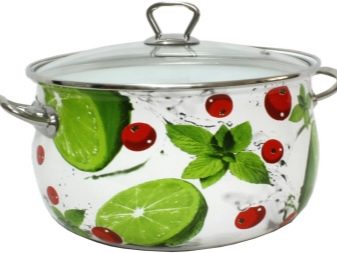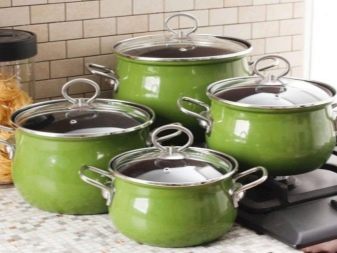Review of manufacturers, selection and use of enamel pans

The housewives hope that the kitchen utensils will serve them for many years, so they take a responsible approach to their choice. Enamelled pots combine functionality and decorativeness. They are in demand and have been tested by more than one generation of housewives. The dishes will serve for many years if you choose them correctly and follow the rules for use.



Advantages and disadvantages
Products are made of carbon stainless steel and coated with enamel. There are pots in which cast iron is the main material. The enamel itself can be applied inside and outside or on one side. Main pluses:
- metal is reliably protected from corrosion;
- the inner surface does not retain food aromas;
- ready meals can be stored for a long time, taste is not distorted;
- can be used on all stoves except induction;
- copes with the preparation of all dishes;
- varied design, you can pick up something beautiful and individual, the dishes look more decorative than any other analogue;
- can be washed in the dishwasher or by hand.


Cookware with an enamel coating shows its negative sides only with prolonged regular use.
- The enamel is fragile, easily damaged by shock or contact with abrasive substances, metal scouring pads. Cracks or even chips may appear.
- If corrosion has developed inside the pan, it can no longer be used for cooking. Damage to the outer enamel layer impairs the decorative properties, but does not affect functionality.
- When used on a gas stove, smoke may appear on the bottom and side walls as a result of contact with powerful flames.
- The thin walls of the pan heat up quickly, though unevenly. If you carelessly, food can stick or even burn, which will negatively affect the taste of the dish.

Dimensions (edit)
The largest saucepan is 9 liters and the smallest is 1.5 liters. Customers choose cookware based on their needs, which explains the wide variety. Enamel pots are sold in sets of several different sizes.
It is worth choosing the size based on the number of people in the family and the purpose of a particular item. The largest volume is chosen for compotes and first courses.

Design
The appearance of enameled pots is quite varied. The main color can be either classic white, black or brighter: red, orange, yellow, green. Dishes with various patterns of natural and urban themes are very popular.
The most beautiful pots are sometimes bought not even for use in the cooking process, but for decorating the kitchen.



Comparison with stainless steel cookware
Enamel cookware has been popular for decades. Young housewives often try to compare such products with uncoated stainless steel counterparts. Pans made from both materials are rust resistant and dishwasher safe. When cooking in stainless steel, burns do not appear, which is especially important when stewing and baking. In enameled dishes, you can make any dishes without fear.
Housewives love to store cooked food in pans, and in this case, the difference between the two types is very noticeable. The stainless steel maintains the temperature inside before serving. However, when stored for a long time, food changes its taste. An enamel pot can be used for this purpose and does not retain the smell of food after washing.
Both pans can be used with induction hobs. In this case, the stainless steel must have a multilayer bottom. Enamelled pans are equipped with ferrimagnetic discs or 3-layer bottom.
Among the shortcomings, it is important to note the lid, handles and raw material of stainless steel products. All parts get hot and deformed during use.


Top manufacturers
In Russia, many firms make high-quality enameled dishes.
- LLC "Enamel". Dishes have been made at the plant in Magnitogorsk since the end of the 50s. The pans are safe and of high quality and have an attractive design. Such dishes of Russian production belong to the budget category of goods and completely maintains a balance between price and quality.
- LLC "Stalemal" also sells its products under the Vitross brand. Various colors and sizes, interesting sets in combination with original shapes make the products popular among buyers.


There are many high-quality products and foreign production on the market - we will give a rating of the best.
- Omelia... Belarusian pots with an enamel coating are made using the latest technologies. It is noteworthy that the covers fit tightly to the rims of the product. This nuance allows you to speed up food preparation.


- Mayer & Boch. China and Germany are working on the pots. A feature of the brand is the use of special specialized steel. During operation, it practically does not deform.

- Ejiry. The Japanese brand offers customers pans with special glass enamel. It contains powdered sugar, which is very unusual. Thick-bottomed pots allow you to cook food without the risk of scalding.

- Thermosol. Finnish products are quite popular and have received a lot of positive feedback from customers. In the manufacture of stainless steel and carbon steel are used. Smooth enamel easily tolerates high temperatures and is quite durable.

- Avsar Enamel. Turkish cookware with enamel coating is not inferior to competitors. Thick steel is used in the manufacture, so the pans take longer to warm up, but more evenly. As a result, food does not stick to the walls and bottom.

Criterias of choice
Enamelled pots or sets will last for years if they are of high quality. It is not difficult to choose such a product, paying attention to a number of parameters.
- Enamel. The layer must be consistent and uniform. The smoothness and shine of the enamel speaks of quality, but the presence of the slightest chips, stains and scratches should be alarming.
- Enamel thickness... This parameter directly depends on the technology with which the layer was applied. When spraying, the enamel is thin and even. However, such a layer may wear off during use. When the product is dipped into enamel, the layer is denser and thicker. If the coating is too much, then it may simply fall off as a result of an impact or fall.
- Bezel. A special detail for pans with enamel. If the bezel on top is made of metal, then corrosion may appear there. This is due to the fact that under the bend, the metal may not be completely covered with enamel.
It should be noted that in the manufacture of enameled pots, metal is used, to which particularly strict requirements are not imposed. This is because there is a coating layer that prevents the steel from contacting food.
High-quality dishes are not always expensive, but you should always take into account all of the above features.


Operating rules
Housewives use enamel pots for cooking first and second courses, stewed fruit and preserves, and preservation. The dishes can be stewed, boiled and even baked. A pan with enamel is not suitable for preparing milk porridge: they burn due to uneven heating.
A new pan needs a special approach. Yet before the first use, it is necessary to strengthen the enamel. Pour water into the container and add salt at the rate of 2 tbsp. l. for 1 liter. Bring liquid to a boil and remove pan from heat. Wait until it cools completely and only then drain the salt water.


An enamel pot will last a long time if used correctly.
- Do not drop the pan and knock with a metal spoon on the walls, bottom. As a result, microcracks are formed, which eventually turn into chips. The enamel covers the finished pan and protects the metal from corrosion, but it is fragile, which must be taken into account.
- It is strictly forbidden to use pots with chipped enamel on the inner surface.
- Sudden changes in temperature will damage the product. Do not pour cold water into a saucepan that has just been removed from the stove. Such negligence will lead to the destruction of the enamel coating.
- Do not leave dishes with liquid in the cold, in the freezer. When frozen, water expands and damages the protective coating.
- Never leave an empty enamel pan on the stove. When overheated, the fragility of the enamel increases, and chips form. After such an incident, it is not allowed to use the utensils for cooking.
- Do not put a large product on a smaller burner, and if you need to do this, use a flame divider. The low thermal conductivity of the enamel plays a key role in this case. The pot simply won't warm up in places that are far from the heat source.
- Do not cook milk porridge and boil milk in such a bowl. If you still need to do this, then first pour chilled water over the pan.
- If the food in the dishes is burnt, do not try to remove it with metal scourers. To cleanse, pour some cold water into a saucepan, add a couple of teaspoons of salt and baking soda and leave alone for 1-1.5 hours. Then rinse with water, regular detergent and a soft sponge. You can also boil water with vinegar or green apple skins in a saucepan.
- If you notice that the enamel on the item has begun to fade, then boil it in water with the addition of a small amount of any dishwashing detergent. Then rinse the pan with plenty of hot running water.
- The enamel pot can be placed in the oven, but the temperature should not exceed 95–150 ° C. Exposure to heat in this case does not harm the protective layer.


For information on how to clean an enamel pot, see the next video.








